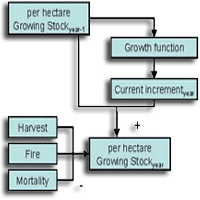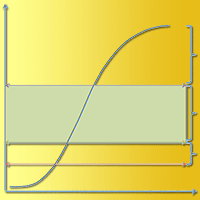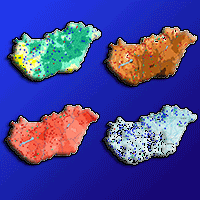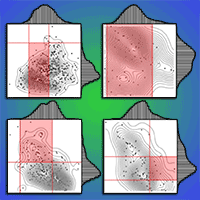The main objective of this study was to estimate past and future dynamics of forest carbon pools in South Korea, as classified by the Intergovernmental Panel on Climate Change (IPCC) Good Practice Guidance (GPG) and to test the Carbon Budget Model of the Canadian Forest Sector 3 (CBM-CFS3). Inventory data required in CBM-CFS3 were extracted from Korea’s 3rd Forest Type Map. The site index in the inventory data was estimated through regression models developed using 5th National Forest Inventory (NFI) data with 4000 plots. Necessary yield tables to a stand age of over 100 years, stratified by species, were prepared through the estimation of volume per ha with tree species, site index and stand age. We considered thinning and cutting regulations for sustainable forest management announced by the Korean Forest Service and that the forest area was constant over from 1992 to 2092. We estimated the carbon stocks and their changes of aboveground (AGB) and belowground (BGB) biomass, litter (L), dead wood (DW), and soil organic matter (SOM). Validation was conducted based on the 5th NFI and statistical data. Our results showed that the carbon content of the total forest area increased from 509.7 Tg C to 1007.3 Tg C at a rate of 11.8 Tg C yr-1 during 1992-2034. Results also showed that AGB, BGB, DW, L and SOM changed from 54.6, 30.2, 15.9, 43.6, and 373.9 Tg C in 1992 to 455.6, 100.77, 32.89, 65.46, and 369.2 Tg C in 2034, respectively. However, the amount of forest carbon was projected to decrease due to large increases in harvest rates as most of the forest reaches the legislated cutting age during 2035-2045. Our simulation estimated that by 2045 AGB, BGB, and SOM decreased to 347.8, 78.2, and 368.9 Tg C, respectively, while DW and L increased to 46.8 and 89.1 Tg C, respectively. The carbon content of the total forested area starts to stabilize after 2045 as the annual stand growth gradually decreases. Finally in 2092, the carbon content of AGB, BGB, DW, L, and SOM was estimated as 422.3, 93.9, 31.2, 63.0, and 365.1 Tg C, respectively. Through harvesting, over the 100 year period more than 200 Tg C were transferred from South Korea’s forests to meet demands for timber, fiber and energy. Good agreement between model results, NFI data and independent studies, demonstrates the applicability of CBM-CFS3 for estimating past and future forest carbon budgets in South Korean forests and for exploring forest management activity impacts in managed forests.
Keywords
, , , ,
Citation
Kim M, Lee W-K, Kurz WA, Kwak D-A, Morken S, Smyth CE, Ryu D (2016). Estimating carbon dynamics in forest carbon pools under IPCC standards in South Korea using CBM-CFS3. iForest 10: 83-92. - doi: 10.3832/ifor2040-009
Academic Editor
Chris Eastaugh
Paper history
Received: Mar 04, 2016
Accepted: Aug 05, 2016
First online: Oct 13, 2016
Publication Date: Feb 28, 2017
Publication Time: 2.30 months
© SISEF - The Italian Society of Silviculture and Forest Ecology 2016
Open Access
This article is distributed under the terms of the Creative Commons Attribution-Non Commercial 4.0 International (https://creativecommons.org/licenses/by-nc/4.0/), which permits unrestricted use, distribution, and reproduction in any medium, provided you give appropriate credit to the original author(s) and the source, provide a link to the Creative Commons license, and indicate if changes were made.

Breakdown by View Type
(Waiting for server response...)
Article Usage
Total Article Views: 53588
(from publication date up to now)
Breakdown by View Type
HTML Page Views: 42432
Abstract Page Views: 4829
PDF Downloads: 4909
Citation/Reference Downloads: 67
XML Downloads: 1351
Web Metrics
Days since publication: 3354
Overall contacts: 53588
Avg. contacts per week: 111.84
Article Citations
Article citations are based on data periodically collected from the Clarivate Web of Science web site
(last update: Mar 2025)
Total number of cites (since 2017): 20
Average cites per year: 2.22
Publication Metrics
by Dimensions ©
Articles citing this article
List of the papers citing this article based on CrossRef Cited-by.
(1)
Ahn JS, Chon CM (2010)Geochemical distributions of heavy metals and Cr behavior in natural and cultivated soils of volcanic Jeju island, Korea. Geosystem Engineering 13: 9-20.
CrossRef |
Gscholar
(2)
Bae JS, Joo RW, Kim YS (2012)Forest transition in South Korea: reality, path and drivers. Land Use Policy 29: 198-207.
CrossRef |
Gscholar
(3)
Bailey RL, Clutter JL (1974)Base-age invariant polymorphic site curves. Forest Science 20: 155-159.
Online |
Gscholar
(4)
Bellassen V, Viovy N, Luyssaert S, Le Maire G, Schelhaas MJ, Ciais P (2011)Reconstruction and attribution of the carbon sink of European forests between 1950 and 2000. Global Change Biology 17: 3274-3292.
CrossRef |
Gscholar
(5)
Böttcher H, Freibauer A, Obersteiner M, Schulze ED (2008)Uncertainty analysis of climate change mitigation options in the forestry sector using a generic carbon budget model. Ecological Modelling 213 (1): 45-62.
CrossRef |
Gscholar
(6)
Boudewyn P, Song X, Magnussen S, Gillis MD (2007)Model-based, volume-to-biomass conversion for forested and vegetated land in Canada. Canadian Forest Service, Victoria, Canada, pp. 111.
Online |
Gscholar
(7)
Byun JG, Lee WK, Kim M, Kwak DA, Kwak H, Park T, Byun WH, Son Y, Choi JK, Lee YJ, Saborowski J, Chung DJ, Jung JH (2013)Radial growth response of
Pinus densiflora and
Quercus spp. to topographic and climatic factors in South Korea. Journal of Plant Ecology 6 (5): 380-392.
CrossRef |
Gscholar
(8)
Choi SD, Chang YS (2004)Factors affecting the distribution of the rate of carbon uptake by forests in South Korea. Environmental Science and Technology 38: 484-488.
CrossRef |
Gscholar
(9)
Choi S, Lee WK, Kwak DA, Lee S, Son Y, Lim JH, Saborowski J (2011)Predicting forest cover changes in future climate using hydrological and thermal indices in South Korea. Climate Research 49: 229-245.
CrossRef |
Gscholar
(10)
Cutini A, Chianucci F, Manetti MC (2013)Allometric relationships for volume and biomass for stone pine (
Pinus pinea L.) in Italian coastal stands. iForest 6: 331-337.
CrossRef |
Gscholar
(11)
Fischer R, Aas W, De Vries W, Clarke N, Cudlin P, Leaver D, Lundin L, Matteucci G, Matyssek R, Mikkelsen TN, Mirtl M, Oztürk Y, Papale D, Potocic N, Simpson D, Tuovinen J-P, Vesala T, Wieser G, Paoletti E (2011)Towards a transnational system of supersites for forest monitoring and research in Europe - an overview on present state and future recommendations. iForest 4: 167-171.
CrossRef |
Gscholar
(12)
IPCC (2003)Good practice guidance for land use, land-use change and forestry. Institute for Global Environmental Strategies (IGES), Hayama, Japan, pp. 675.
Online |
Gscholar
(13)
IPCC (2000)Special report on emissions scenarios. Cambridge University Press, Cambridge, UK, pp. 881.
Online |
Gscholar
(14)
Ito A (2008)The regional carbon budget of East Asia simulated with a terrestrial ecosystem model and validated using AsiaFlux data. Agricultural and Forest Meteorology 148: 738-747.
CrossRef |
Gscholar
(15)
Jordan L, Souter R, Parresol B, Daniels RF (2006)Application of the algebraic difference approach for developing self-referencing specific gravity and biomass equations. Forest Science 52: 81-92.
Online |
Gscholar
(16)
Korea Forest Research Institute (2011)The 5th national forest inventory report. Korea Forest Research Institute, Seoul, Rep. of Korea, pp. 166.
Online |
Gscholar
(17)
Korea Forest Service (2000)Forest and forestry technique. Korea Forest Service, Daejeon, Rep. of Korea, pp. 513.
Online |
Gscholar
(18)
Korea Forest Service (2009)Table of tree volume/mass and yield table. Korea Forest Service, Daejeon, Rep. of Korea, pp. 261.
Online |
Gscholar
(19)
Korea Forest Service (2011)Statistical Yearbook of Forestry 2011. Korea Forest Service, Daejeon, Rep. of Korea, pp. 41.
Online |
Gscholar
(20)
Korea Forest Research Institute (2014)Carbon emission factors and biomass allometric equations by species in Korea. Korea Forest Research Institute, Seoul, Rep. of Korea, pp. 97.
Online |
Gscholar
(21)
Kull SJ, Kurz WA, Rampley GJ, Banfield GE, Schivatcheva RK, Apps MJ (2006)Operational-scale carbon budget model off the Canadian forest sector (CBM-CFS3) Version 1.0: user’s guide. Natural Resources Canada, Canadian Forest Service, Edmonton, Canada, pp. 319.
Online |
Gscholar
(22)
Kurz WA, Stinson G, Rampley GJ, Dymond CC, Neilson ET (2008)Risk of natural disturbances makes future contribution of Canada’s forests to the global carbon cycle highly uncertain. Proceedings of the National Academy of Sciences USA 105: 1551-1555.
CrossRef |
Gscholar
(23)
Kurz WA, Dymond CC, White TM, Stinson G, Shaw CH, Rampley GJ, Smyth C, Simpson BN, Neilson ET, Trofymow JA, Metsaranta J, Apps MJ (2009)CBM-CFS3: a model of carbon-dynamics in forestry and land-use change implementing IPCC standards. Ecological Modelling 220: 480-504.
CrossRef |
Gscholar
(24)
Kurz WA, Shaw CH, Boisvenue C, Stinson G, Metsaranta J, Leckie D, Dyk A, Smyth C, Neilson ET (2013)Carbon in Canada’s boreal forest - A synthesis. Environmental Reviews 21: 260-292.
CrossRef |
Gscholar
(25)
Kwak DA, Lee WK, Son Y, Choi S, Yoo S, Chung DJ, Lee SH, Kim SH, Choi JK, Lee YJ, Byun WH (2012)Predicting distributional change of forest cover and volume in future climate of South Korea. Forest Science and Technology 8: 105-115.
CrossRef |
Gscholar
(26)
Landsberg JJ, Waring RH (1997)A generalized model of forest productivity using simplified concepts of radiation-use efficiency, carbon balance and partitioning. Forest Ecology and Management 95 (3): 209-228.
CrossRef |
Gscholar
(27)
Lee J, Yoon TK, Han S, Kim S, Yi MJ, Park GS, Kim C, Son YM, Kim R, Son Y (2014)Estimating the carbon dynamics of South Korean forests from 1954 to 2012. Biogeosciences 11: 4637-4650.
CrossRef |
Gscholar
(28)
Lemprière TC, Kurz WA, Hogg EH, Schmoll C, Rampley GL, Yemshanov Y, McKenney DW, Gilsenan R, Beatch A, Blain D, Bhatti JS, Krcmar E (2013)Canadian boreal forests and climate change mitigation. Environmental Reviews 21: 293-321.
CrossRef |
Gscholar
(29)
Levy E, Hale SE, Nicoll BC (2004)Biomass expansion factors and root: shoot ratios for coniferous tree species in Great Britain. Forestry 77 (5): 421-430.
CrossRef |
Gscholar
(30)
Li Z, Kurz WA, Apps MJ, Beukema SJ (2003)Belowground biomass dynamics in the Carbon Budget Model of the Canadian Forest Sector: recent improvements and implications for the estimation of NPP and NEP. Canadian Journal of Forest Research 33: 126-136.
CrossRef |
Gscholar
(31)
Lindroth A, Lagergren F, Grelle A, Klemedtsson L, Langvall O, Weslien P, Tuulik J (2009)Storms can cause Europe-wide reduction in forest carbon sink. Global Change Biology 15 (2): 346-355.
CrossRef |
Gscholar
(32)
Liski J, Lehtonen A, Peltoniemi M, Eggers T, Muukkonen P, Mäkip R (2006)Carbon accumulation in Finland’s forests 1922-2004 - an estimate obtained by combination of forest inventory data with modelling of biomass, litter and soil. Annals of Forest Science 63: 687-697.
CrossRef |
Gscholar
(33)
Lull HW, Ellison L (1950)Precipitation in relation to altitude in Central Utah. Ecology 31: 479-484.
Online |
Gscholar
(34)
Luyssaert S, Ciais P, Piao SL, Schulze ED, Jung M, Zaehle S, Schelhaas MJ, Reichstein M, Churkina G, Papale D, Abril G, Beer C, Grace J, Loustau D, Matteucci G, Magnani F, Nabuurs GJ, Verbeeck H, Sulkava M, Van Der Werf GR, Janssens JA, Carboeurope-IP Synthesis Team (2010)The European carbon balance Part 3: forests. Global Change Biology 16: 1429-1450.
CrossRef |
Gscholar
(35)
Metherall AK, Harding LA, Cole CV, Parton WJ (1994)CENTURY Soil Organic Matter Model Environment Technical Documentation, Agroecosystem Version 4.0. Tech Rep No. 4.0, Great Plains System Research Unit, USDA-ARS, Fort Collins, CO, USA, pp. 123.
Online |
Gscholar
(36)
Metsaranta JM, Dymond CC, Kurz WA, Spittlehouse DL (2011)Uncertainty of 21st century growing stocks and GHG balance of forests in British Columbia, Canada resulting from potential climate change impacts on ecosystem processes. Forest Ecology and Management 262: 827-837.
CrossRef |
Gscholar
(37)
Mitscherlich EA (1919)Problems of plant growth. Landwirtschaftliche Jahrbucher 53: 167-182.
Gscholar
(38)
Nabuurs GJ, Schelhaas MJ (2002)Carbon profiles of typical forest types across Europe assessed with CO2FIX. Ecological Indicators 1 (3): 213-223.
CrossRef |
Gscholar
(39)
Nabuurs GJ, Schelhaas MJ, Pussinen A (2000)Validation of the European Forest Information Scenario Model (EFISCEN) and a projection of Finnish forests. Silva Fennica 34 (2): 167-179.
CrossRef |
Gscholar
(40)
Nam KJ, Lee WK, Kim M, Kwak DA, Byun WH, Yu H, Kwak H, Kwon T, Sung J, Chung D, Lee SH (2015)Spatio-temporal change in forest cover and carbon storage considering actual and potential forest cover in South Korea. Science China Life Sciences 58 (7): 713-723.
CrossRef |
Gscholar
(41)
Oubrahim H, Boulmane M, Bakker MR, Augusto L, Halim M (2015)Carbon storage in degraded cork oak (
Quercus suber) forests on flat lowlands in Morocco. iForest 9: 125-137.
CrossRef |
Gscholar
(42)
Pan Y, Birdsey RA, Fang J, Houghton R, Kauppi PE, Kurz WA, Phillips OL, Shvidenko A, Lewis SL, Canadell JG, Ciais P, Jackson RB, Pacala P, McGuire AD, Piao S, Rautiainen A, Sitch S, Hayes D (2011)A large and persistent carbon sink in the World’s forests. Science 333: 988-993.
CrossRef |
Gscholar
(43)
Peltoniemi M, Palosou T, Monni S, Mäkipää R (2009)Factors affecting the uncertainty of sinks and stocks of carbon in Finnish forests soils and vegetation. Forest Ecology and Management 232: 75-85.
CrossRef |
Gscholar
(44)
Pilli R, Grassi G, Kurz WA, Smyth CE, Blujdea V (2013)Application of the CBM-CFS3 model to estimate Italy’s forest carbon budget, 1995-2020. Ecological Modelling 266: 144-171.
CrossRef |
Gscholar
(45)
SAS Institute Inc. (2003)SAS/STATTM user’s guide (version 9.1). Cary, NS, USA, pp. 34.
Gscholar
(46)
Schumacher FX (1939)A new growth curve and its application to timber-yield studies. Journal of Forest 37: 819-820.
Gscholar
(47)
Segura M, Kanninen M (2005)Allometric models for tree volume and total aboveground biomass in a tropical humid forest in Costa Rica. Biotropica 37: 2-8.
CrossRef |
Gscholar
(48)
Sit V, Poulin-Costello M (1994)Catalogue of curves for curve fitting. Forest Science Research Branch of Ministry of Forest, Victoria, BC, Canada, pp. 110.
Online |
Gscholar
(49)
Tak K, Chun Y, Wood PM (2007)The South Korean forest dilemma. International Forestry Review 9 (1): 548-557.
CrossRef |
Gscholar
(50)
Webb LJ (1968)Environmental relationships of the structural types of Australian rain forest vegetation. Ecology 49 (2): 296-311.
CrossRef |
Gscholar
(51)
Wirth C, Schumacher J, Schulze ED (2004)Wirth C, Schumacher J, Schulze ED (2004) Generic biomass functions for Norway spruce in Central Europe - a meta-analysis approach toward prediction and uncertainty estimation. Tree Physiology 24: 121-139.
CrossRef |
Gscholar


















